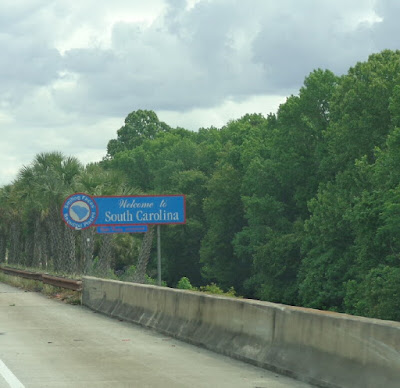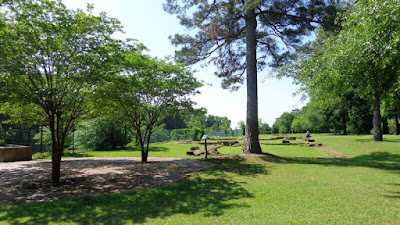This entry will be from April 28th through May 4th and will include Woodbine, Georgia, Yemassee, SC, and Fayetteville, NC. We did a lot in these few days but as always will just include the highlights.
_________________________________________
Patty tries to take "Welcome to" State sign pictures. Here we are entering Georgia.
 |
| Welcome to Georgia |
We arrived on Thursday the 28th in Woodbine GA. This is a Passport America Park so I get half price on this camping site. It is owned by a transplanted Austrailian hence the name Walkabout RV Camp with a boomerang in their logo. Sites are pull through on grass with full 50 amp hookups.
 |
| Walkabout RV Camp and RV Park |
We were just going to stay two nights in Georgia but found out they were having a Crawfish festival the day we were leaving so we extended an extra day. We found the Tabby Sugar Works Ruins in St. Mary's. McIntosh (Or Tabby) Sugarworks was built in the late 1820s by John Houstoun McIntosh. They are a significant example of tabby architecture and represent an industrial component of southeastern plantation agriculture. Tabby is a type of concrete made by burning oyster shells to create lime, then mixing it with water, sand, ash and broken oyster shells.
 |
| Tabby Sugar Works Ruins |
Tabby was used by early Spanish settlers in present-day North Carolina and Florida, then by English colonists primarily in coastal South Carolina and Georgia.
 |
| Tabby Ruins |
In this picture you can see Patty and a closer picture of the Tabby concrete.
 |
| Tabby Concrete |
You can see the oyster shells here and how large the facility is by how many doors there are.
 |
| Door Ways |
We did a tour of the town of St. Mary's, Georgia. For $10.00 for two of us they drove us around in a golf cart and showed us all the historical sites in town. It took over an hour and was well worth it. This sign was for the Nesbitt House. It had quite some history!
 |
| Clark - Nesbitt Home Sign |
Tom Nesbitt was a descendant of Archibald Clark, the home’s most storied owner. Clark lived in the home from 1804 until his death in 1848. He was appointed in 1807 by then-President Thomas Jefferson as customs collector for the Port of St. Marys, a position he held until his death. The year Clark bought the house, he is said to have provided a temporary hideout to Aaron Burr, who was traveling in the South to evade federal authorities holding a warrant for his arrest after he killed Alexander Hamilton in their infamous duel in July 1804. Clark is also said to have hosted Army General Winfield Scott in the home as Scott was returning home from service in the Mexican-American War.
 |
| Clark - Nesbitt Home |
This is the Orange Hall House. Apparently got it's name from some sour orange trees in the back yard.
 |
| Orange Hall House |
Originally built by Reverend Horace Pratt.
 |
| Orange Hall |
Saturday was the Crawdad Festival in Woodbine. We enjoy small town parades. Here are the old Farmall and John Deer tractors.
 |
| Vintage Tractors |
And of course the Crawfish Festival float with the Crawfish on it!
 |
| Crawfish Festival |
We walked to the festival from the parade along the riverfront.
 |
| River Front Walk |
As we were walking several people started pointing to the river. What was there, but a big gator!!!!!
 |
| See ya Later, Alligator! |
Both Patty and I have eaten Crawfish (or Crawdads) if you prefer. In fact we just had some Crawfish Etouffee while in Louisiana. What we have never tried was what we had just seen in the river, GATOR! There was a booth that was serving fried gator on a stick. We had to try it.
 |
| Gator on a Stick |
You know how they say snake or frog legs taste like chicken? Well so does gator, well at least this did, but it was drier then chicken, not very moist. It was OK and we finished it, but it was expensive and not as good as chicken, but we can say we have now eaten Alligator!!!
Better then it eating us!! LOL!
Sunday we normally don't travel because it's church day for us. We try and find a church and fellowship with other Christians. This is very important to us. This just didn't work out on this Sunday. We did get to live stream some of our service from New Life in Oxnard, California which is nice. We appreciate that they offer that. Our son Matthew is in charge of that now as he has taken on the I.T. duties at church.
Anyway we have now entered South Carolina and heading to Yemassee.
 |
| Welcome to South Carolina |
What's in Yemassee? a Thousand Trails campground which means that we stay FREE! Yay!
We arrived at the "Oaks at South Point" in Yemassee, SC.
We found a long pull through with 50 amp. All the sites are covered with thick tree cover so I knew satellite was out of the question, but somehow the dish on the roof found a signal!
 |
| Oaks at South Point |
The Frampton Plantation is nearby. There are Civil War ties to it including bunkers that are still here.
 |
| Frampton Plantation |
There are even Revolutionary War ties. This is a marker for a Revolutionary War trail.
 |
| Revolutionary War Trail |
The Old Sheldon Church Ruins are within about 5 miles of camp. The building was originally known as Prince William's Parish Church. The church was built as a chapel of ease in the Greek Revival style between 1745 and 1753. Prince William's was burned by the British in 1779 during the Revolutionary War. In 1826 it was rebuilt.
 |
| Old Sheldon Church Ruins |
The following is from an article in the April 1969 Sandlapper Magazine by Charles E. Thomas, “The Picturesque Ruins Of Old Sheldon Church”. “The official South Carolina report on the “Destruction of Churches and Church Property,” after the War Between the States, described Sheldon’s second burning: “All that was combustible was consumed..., its massive walls survive the last as they did the former conflagration,” Bishop Thomas wrote, “Exactly as it happened a hundred years before in 1779, when General Prevost, marching from Savannah into South Carolina burned the Church, so now in February 1865, General Sherman marching from Georgia into South Carolina, burned it a second time.”
 |
| Church Ruins |
There are also tombstones and crypts on the site. You can see one to the left of the pillar.
 |
| Ruins and Tombs |
The next day we drove to Hilton Head Island. We wanted to go to the lighthouse at Hilton Head Harbor. It turns out the harbor is in a gated community. They charge you to pass a gate. A pickup truck is $6.00. OK I can live with that. Because I have a Dually pickup, they consider that a commercial large vehicle like a box truck or an 18 wheeler and said I would have to pay $26.00 to get through the gate!! I don't think so!! No lighthouse for us!
 |
| Hilton Head Beach |
Or maybe there was?
Turns out there is another one called Hunting Island Lighthouse and it is open for tours.
 |
| Hunting Island Lighthouse |
The spiral staircase going up the lighthouse.
 |
| Spiral Staircase |
Patty at her happy place at the top of the lighthouse!
 |
| Top of the Lighthouse |
The Anglican chapel was constructed in 1740 by planters on Saint Helena Island as a chapel of ease for parishioners who had difficulty travelling to worship at the main parish church in Beaufort, South Carolina.
 |
| Chapel of Ease |
We are amazed by how many old, really old ruins we are coming across!
 |
| Chapel of Ease |
Most of the ruins also have graves and tombs. We do notice that many of the the old churches that are still functioning also have graveyards next to them.
 |
| Chapel and Tombs |
That's it for our two days in South Carolina, now we head for North Carolina.
Welcome to North Carolina!!
 |
| North Carolina |
We are staying in a Passport America park called Art's RV in Fayetteville. The GPS seemed like it was heading us to the end of a residential street to a guys back yard. The reviews on the internet were OK, so we will see.
 |
| Art's RV |
As it turns out that is exactly what it is. Art has a large lot at the end of a cul-de-sac and has installed about 15 full hookups. As you can see I backed up to his neighbors fence and hooked up. There was plenty of room to back up and at least it felt safe. It was Passport America so the price was right so it worked out fine.
TripAdvisor suggested going to the Poe House. It is Edgar Allen Poe, but not THAT Edgar Allen Poe.
 |
| Poe House |
It is named after the successful businessman, politician, and civic leader who built it; not the well-known American author Edgar Allan Poe. To avoid confusion, the Fayetteville native is generally referenced as "E. A." in the local area and the historic house museum is known simply as Poe House. It is also referenced as the 1897 Poe House and part of the Museum of the Cape Fear Historical Complex.
 |
| Poe House |
They did several tours of the house a day and surprisingly the tours were free. They did suggest a modest $2.00 donation.
 |
| Living Room |
This is all part of the Cape Fear Arsenal Museum. The United States Arsenal in Fayetteville, North Carolina was destroyed by the same government that commissioned its construction. After the War of 1812, the U.S. wanted to expand its defenses and commissioned the construction of five arsenals. Fayetteville, NC was chosen as a site for one of those new arsenals.
 |
| Dining Area |
By 1858, just three years prior to the Civil War, the arsenal facility was just about complete. When North Carolina seceded from the Union in April 1861, local militia took the arsenal, turned it over to the State of North Carolina, who in turn gave it to the new Confederate States of America.
The Confederacy used the arsenal to produce rifles, ammunition, and gun carriages. Union troops, commanded by Gen. William T. Sherman, destroyed the facility in 1865.
 |
| Arsonal Park |
We wanted to go to a battlefield. Bentonville Battlefield was not to far, so we went there. There was confederate and union graveyards.
 |
| Confederate Graveyard |
More headstones.
 |
| Union Graveyard |
It is amazing how much history we are finding so far. There is so much more to come.
Thank you for reading the blog,
God bless you,
Brian and Patty

















































